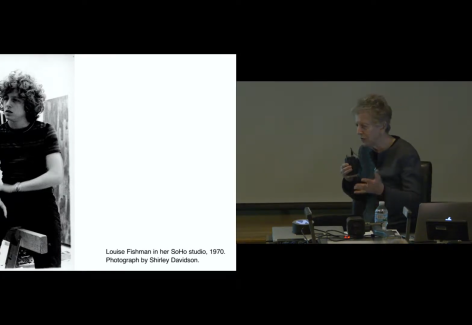JLS: Non-specialists might associate contemporary art with taste and market trends, instead of the historical past or fieldwork. How do you think about research for your curatorial practice?
ALP: Like any area of art history, periodization is a shifting question in contemporary art. Depending on the context of a given inquiry or project, I could be as concerned with Marcel Duchamp or Claude Cahun or the circumstances that gave rise to globalized exhibitions after 1989.
Research in my curatorial practice involves framing art history in order to understand how studio practices are drawing from long historical lineages and how they shape new ways of thinking right now. The University of Illinois began collecting the art of our time in 1948, when some of the oldest institutions of contemporary art were established in the United States—the Contemporary Arts Museum Houston and the ICA Boston, for example. Before KAM was even established, this campus had been a significant center for contemporary art, and our collection and exhibition program reflect this long history.
JLS: You’ve recently been awarded a prestigious grant from the Luce Foundation for your upcoming exhibition A Question of Emphasis: Louise Fishman Drawing. What are the central research questions for that project?
ALP: Louise Fishman is a major abstract painter who graduated from the School of Art + Design’s MFA program in 1965. Her large canvases, like Blonde Ambition (1995) in KAM’s collection, have received a lot of attention for her process-driven work and for her genealogy in art history, because she is conversant with (and ranks among) a range of stalwarts from abstract expressionists like Franz Kline to some of her favorite “teachers” in Chaim Soutine, John Cage, and Agnes Martin.
When I met her in 2017, I was able to see some of her works on paper that had never been shown. Through return visits to her studio in Chelsea, I was astonished by her decades-long drawing practice that has mapped the intimacies in her life: many painted books and works on paper are dedicated to her former lovers, an illustrious network of radical lesbian feminist writers and thinkers in New York. This exhibition and accompanying catalogue examine Louise’s works on paper to argue for drawing as a major pursuit, because it has not been marginal to her paintings. Louise prefigured queer theory, and her work has yet to be fully understood for its implications for kinship and art history.
JLS: Most of your recent research has focused on artists who are still alive. What are the pleasures and challenges of that work?
ALP: I LOVE working with artists. My relationships with artists are like oxygen: in addition to sheer creativity, they make substantial contributions to the most pressing concerns in intellectual, political, and social life. As a curator, I get to see their work develop, realize it as a spatial and intellectual experience, and connect their practices with scholarship across the humanities.
Among the work’s biggest challenges are that I have to be an effective project manager; it’s not all reading and travel and other pleasure work. But the payoff—seeing an exhibition open or a catalogue published—brings the utmost rewards, because my work together with artists endures far beyond their time at KAM.





